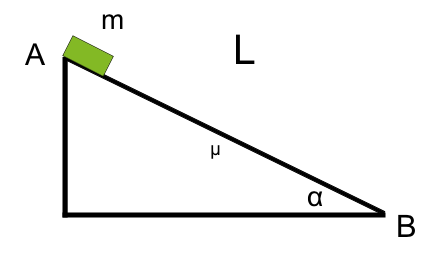What's the speed after moving down the inclined plane?
A body starts moving downwards (from rest) from the upper point of an inclined plane ( ). What is the formula of the velocity when the object arrives at the base of the plane ( )?

Details:
The velocity should be expressed in terms of:
-
The length of the inclined plane, .
-
Its angle, .
-
The coefficient of friction on the plane, .
-
The gravitational acceleration, .
This section requires Javascript.
You are seeing this because something didn't load right. We suggest you, (a) try
refreshing the page, (b) enabling javascript if it is disabled on your browser and,
finally, (c)
loading the
non-javascript version of this page
. We're sorry about the hassle.
At the very top of the plane, the object has no initial velocity, hence its energy is equal to its potential energy:
E A = P E A = m g l sin α
The friction force acts on the body as well, and the formula is:
F f = μ m g cos α
The work of the friction force is:
W F f = − L ⋅ F f = − L μ m g cos α
Applying the law of mechanical energy conservation:
E B = E A + W F f
E B = m g L sin α − L μ m g cos α
Also note that at point B , the object has no potential energy, hence:
E B = K E B = 2 m v B 2
2 m v B 2 = m g L ( sin α − μ cos α )
2 v B 2 = g L ( sin α − μ cos α )
⟹ v B 2 = 2 g L ( sin α − μ cos α )
v B = 2 L g ( sin α − μ cos α )